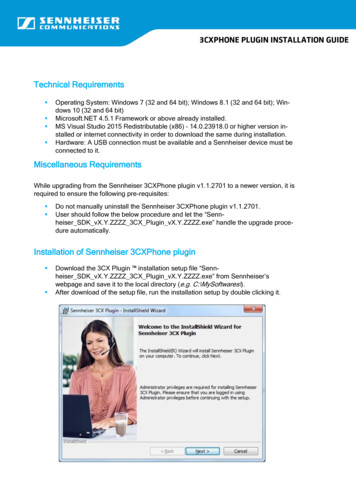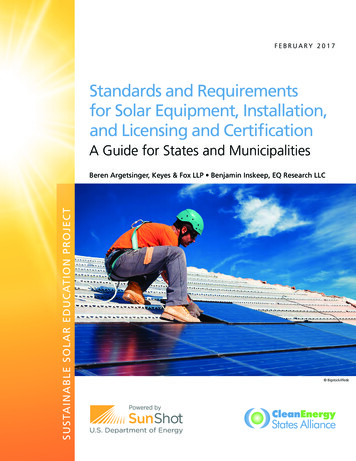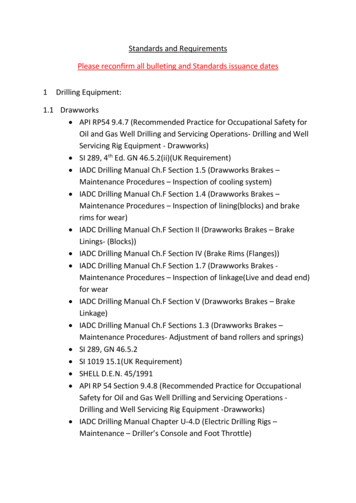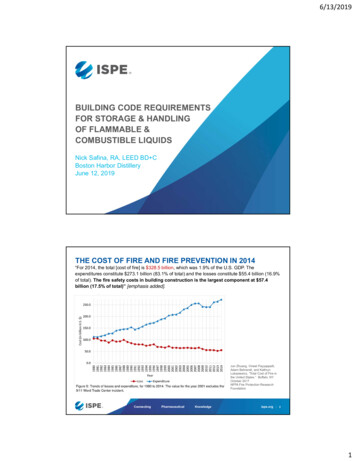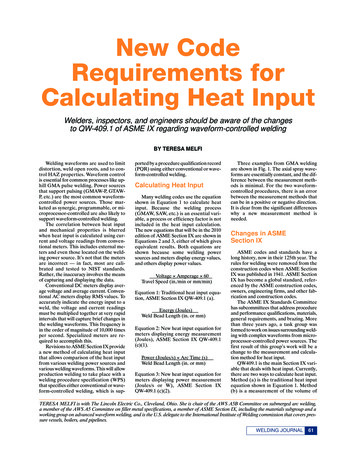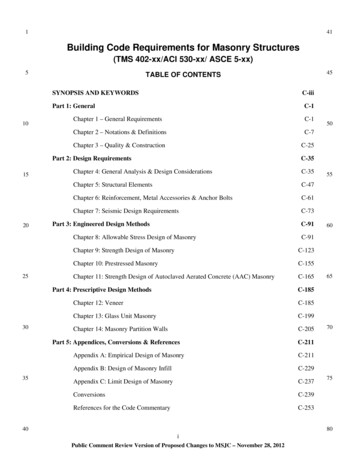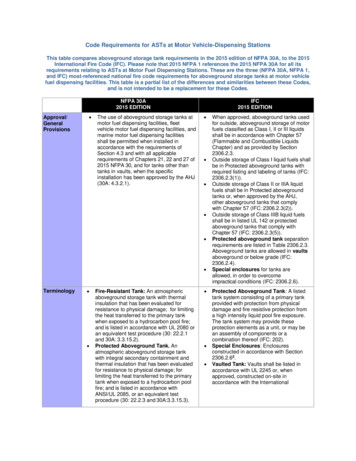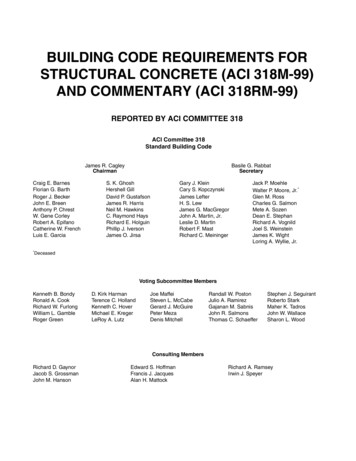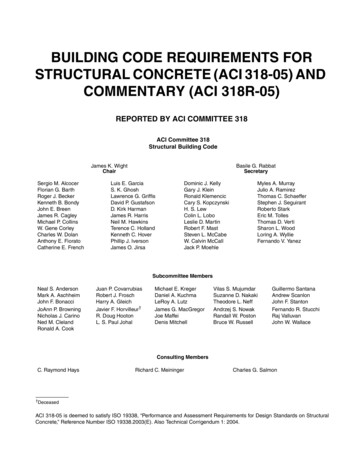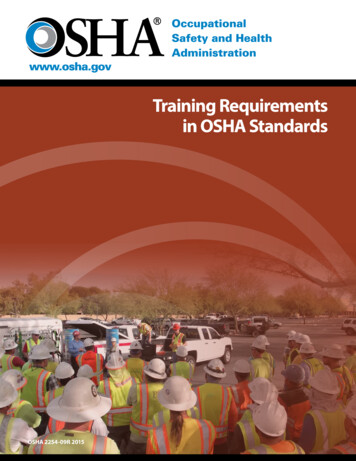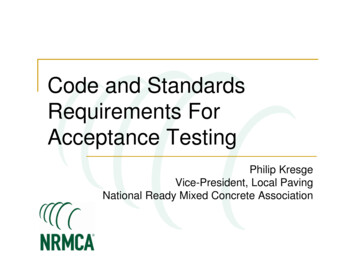
Transcription
Code and StandardsRequirements ForAcceptance TestingPhilip KresgeVice-President, Local PavingNational Ready Mixed Concrete Association
DisclaimerThis presentation has been prepared solely for information purposes. It isintended solely for the use of professional personnel, competent to evaluatethe significance and limitations of its content, and who will accept fullresponsibility for the application of the material it contains. The NationalReady Mixed Concrete Association and any other organizations cooperatingin the preparation of this presentation strive for accuracy but disclaim anyand all responsibility for application of the stated principles or for theaccuracy of the content or sources and shall not be liable for any loss ordamage arising from reliance on or use of any content or principlescontained in this presentation. Unless otherwise indicated, all materials inthis presentation are copyrighted to the National Ready Mixed ConcreteAssociation. All rights reserved. Therefore reproduction, modification orretransmission in any form is strictly prohibited without the prior writtenpermission of the National Ready Mixed Concrete Association. 2018National Ready Mixed Concrete Association.WWW. NRMCA.ORG
Purpose of Acceptance Testing Concrete supplied complies with specificationSampling and testing should comply with standards 1 cu.ft. sample represents 10 cubic yards OR 150 cubic yards (depending on frequency)Improper procedures generate inaccurate results Will cost someoneWill delay projectWWW. NRMCA.ORG
Scope of Testing Samples obtained in accordance with ASTM C172 Point of delivery from transportation unit (or mixer)Other sampling methods should be definedFresh Concrete tests Slump or slump flow – tolerances in ASTM C94; ACI 117Air content – tolerance 1.5%Temperature – limits in specificationsDensity – typically no limits unless its lightweight concreteStrength specimens Average of two 6x12 in or three 4x8 in cylindrical specimensStandard cured in accordance with ASTM C31Tested in accordance with ASTM C39 at 28 days or as per specWWW. NRMCA.ORG
Standard Curing vs. Field Curing Quality controlDeveloping mixtureproportions for strengthrequirementsAcceptance testing forspecified strength Removal of forms orshoringMinimum strength forpost-tensioningDetermine if structurecan be put into serviceAdequacy of curingand protectionCompare with standardcured or with other in-placetestsWWW. NRMCA.ORG
ACI Strength Acceptance CriteriaTest results - Should meet both criteria 1. Average of 3 consecutive ƒ c 2. Single test (ƒ c – 500) For ƒ c 5000 psi – Single test 0.9ƒ cProbability of failure 1 in 100 (1%)WWW. NRMCA.ORG
ACI 318-14 for Low Strength ResultsAvg 3 consecutive - less than ƒ c Increase strength levelSingle test - less than (ƒ c - 500) Increase strength levelInvestigate low strength - structural safety Reduced load carrying capacity of structure confirmedby calculationsCore testsWWW. NRMCA.ORG7
Field Cured Cylinders For evaluating protection and curing ofstructure (ACI 318) Acceptable if field cured cylinders 85% of companion lab curedOr (ƒ c 500) psi Also used for formwork removal,post-tensioningWWW. NRMCA.ORG8
Requirements for LaboratoriesACI 318ACI 301WWW. NRMCA.ORG9
Quality AssuranceTesting Lab conducting QA testing Conformance to ASTM C1077 Technicians Certified InspectedAccreditedField TestingStrength TestingLab TestingTesting in accordance with ASTM or AASHTOTimely distribution of test reports to all partiesWWW. NRMCA.ORG10
Laboratories – ASTM C1077Quality System Written manualUnder direction of PEPersonnel evaluationEquipment calibrationInventory controlParticipation in proficiency sample programLaboratory inspection and accreditationWWW. NRMCA.ORG
Factors Affecting StrengthWWW. NRMCA.ORG
Frequent violations - TestingReason (Average strength reduction) Initial curing (30%) Damaging “green” specimens (18%) Filling in one layer (17%) From chute / no tapping (12%) Top etching / no lids (11%)Adapted from SnellWWW. NRMCA.ORG
Frequent violations - TestingWWW. NRMCA.ORG
Acceptance of concreteACI 318 Section 26.12.3.1WWW. NRMCA.ORG
Strength Test SpecimensStandard Curing - ASTM C31 Maintain moisture Initial temperature in field 60 F to 80 Fƒ c 6000 psi - 68 F to 78 FTransport to lab within 48 hrsTransportation time 4 hrs or lessLab curing 73.5 3.5 F and moistWWW. NRMCA.ORG
ASTM C31 Note 8 – Standard CuringSatisfactory moisture environment Immerse in waterStore in wooden boxes or structuresPlace in damp sandCover with removable lidsPlace inside plastic bagsCover with plastic sheets or plates – with dampburlapWWW. NRMCA.ORG
ASTM C31 Note 8 – Standard CuringSatisfactory temperature environment Use of ventilation Use of ice Thermostatically controlled heating or cooling Heat, such as stoves or light bulbs Immersion in water may be easiest to controltemperatureWWW. NRMCA.ORG
Violation of standard proceduresInitial Curing is most frequent problemWWW. NRMCA.ORG
Field ObservationProperly storedin initial curingenvironment 1/3of timeWWW. NRMCA.ORG
Initial Curing OptionsWWW. NRMCA.ORG
Using SandWWW. NRMCA.ORG
Immerse in Water/CoolersAdd water (use ice if needed) and insert hi-low thermometerWWW. NRMCA.ORG
Temperature ControlledWWW. NRMCA.ORG
Effects of Initial CuringHot WeatherSeries D338 Concrete Strength - Hot Weather Exposure600085804000753000702000Avg. Daily Temp, FCompressive Strength, psi5000Standard Curing6548h out - moist1000OutsideAvg daily temp0600102030405060708090Age, daysWWW. NRMCA.ORG
Effects of Initial CuringCold Weather5000704000553000402000Standard Curing48h out - moistOutsideAvg daily temp32F1000250A v g . D a ily T e m p , F85C o m p re s s iv e S tre n g th , p s i60001001020304050Age, days60708090WWW. NRMCA.ORG
Effects of Initial CuringImportance of temperature and duration of initial curing on28-day compressive strengthInitial Curing(days)Relative StrengthInitial Curing Temp37 FMoist cured73 F100 F100% (5590 CA Pub 53; Delmar L. Bloem,1954WWW. NRMCA.ORG
Effects of Initial CuringImportance of temperature and moisture during first 24hours of initial curing – on 28-day compressive strengthTemp RangeRelativestrengthJobsite* – Curing box; in water71 - 76ºF100%Lab – immersed in water73 - 82ºF100%Lab – in air78 - 82ºF88%Jobsite* – not protected71 - 107ºF85%Jobsite* – covered with wet burlap94 - 135ºF83%Condition (1 day initial curing)4860 psi* Cylinders were kept exposed to sunlight; thermometer shieldedData from F. Kozeliski – New Mexico, 2016WWW. NRMCA.ORG
Effects of Initial CuringInitial curing for 24 hours - Within limits of ASTM C31ConditionRelative Strength (28-day)Cement ACement B100% (6080 psi)100% (6090 psi)60 F in air92%97%80 F in water89%93%80 F in air81%88%60 F in waterBoth temperature limits and moisture provision matterAverage Effect:Water vs. Air 6.6%60 F vs. 80 F 9.2%60 F water vs. 80 F air 16%NRMCA study: Meininger, ASTM Cement Concrete & Aggregates, 1983WWW. NRMCA.ORG
ASTM C31 – ReportWWW. NRMCA.ORG
Statements in Laboratory ReportsWWW. NRMCA.ORG
Responsibilities for TestingACI 301WWW. NRMCA.ORG
Responsibilities for TestingACI 301WWW. NRMCA.ORG
Responsibilities for TestingWWW. NRMCA.ORG
Review of a Test Report Reporting requirements of C31and C39Dates – pour, cylinders made,rec’d at labAmbient / concrete temperatureSlump, air content, densityDuration of initial curingMin / max temperaturesCuring method7 & 28 day strengths Strength gainWWW. NRMCA.ORG35
Transporting Hardened CylindersVariables: Timing Duration of Travel Up to 48 hrs, or8 hrs after final set4 hoursProper CushioningProtect from FreezingProtect from Moisture LossWWW. NRMCA.ORG
Evaluating Test ResultsWhat do Standards Say Responsibilities Reporting Data evaluation PrecisionRating test resultsWWW. NRMCA.ORG
Testing variability (ACI 214R) Within-batch coefficient of Variation (V1)Average range ( ) from10 tests Average strengthNo. Specimensd221.12831.69342.059WWW. NRMCA.ORG
Example Calculation of V1Cylinder 1, psiCylinder 2, psiStrength Test Result, psiRange, 280207Average207s1 184 psi1.128184V1 100 3.2%5837WWW. NRMCA.ORG
Within-batch precisionQuality Standards (ACI 214) Excellent Very GoodGoodFairPoorV1, % 3.03.0 to 4.04.0 to 5.05.0 to 6.0 6.0Average Range of 2Companion Cylinders(assuming avg. 4800 psi) 162162 to 217 217 to 271271 to 325 325 V1 6% - reason to question testingV1 between 4 and 6% - potential problemsV1 between 2 and 3% - C39 testing variation 1.5% - likely too good to be trueWWW. NRMCA.ORG
ASTM C39 Single Operator precision Companion cylinders tested at same ageAcceptable range should not be exceededmore often than 1 time in 20WWW. NRMCA.ORG
Example Calculation within-batch RangeCylinder 1, psi Cylinder 2, psi Test Result, psi Range, psiRange, eWWW. NRMCA.ORG
Example Calculation - within batch RangeNo.Cylinder vingbatchAverage of average ofrange, %10 Tests10 RangesMoving 10 testV1, 44) 6.3%6.5%123880408239812025.1%39732675.9%WWW. NRMCA.ORG
Control Charts to Monitor Testing25%15%10%10%5%0%05101520Sample Number2530Within-batch Coefficient of VariationWithin-batch Range20%9%8%7%Poor6%Fair5%Good4%Very good3%Excellent2%05101520Sample Number2530WWW. NRMCA.ORG
Evaluating Strength Data Poor job site curing will reduce strengthBut may not reflect within batch variation, V1WWW. NRMCA.ORG
ASTM C39 Multi-lab precision COV 5%Acceptable difference between 2 14%Useful for companion testingSame sample tested by 2 labs at same age Split samples (same wheelbarrow or same load)WWW. NRMCA.ORG
Companion Tests8000Companion Strength Test DataCompressive Strength, psi70006000Test Lab5000CompanyLab Avg40003000Mar-13Comp AvgApr-13May-13Jun-13Jul-13Aug-13DateCompany Data at plant; Lab data at jobsiteSpecimens from the same sample are better toevaluate for multi-lab precision WWW. NRMCA.ORG
Importance of Good TestingStrength Standard Deviation (variability) MaterialsProductionTestingComponents of variation are cumulativeReducing Testing Variation helps isolateother causes of variation that the producercan controlWWW. NRMCA.ORG
What if you have Low Test Results?NRMCA Pub 133 Confirm likelihood of low strength Verify testing accuracyNon destructive testsStructural capacity reduced (Engineer decision)? Core testsLoad testsCorrective measuresEstablish responsibility (monetary) for lowstrength evaluations (pre-construction)WWW. NRMCA.ORG
Testing Concrete CoresACI 318 criteria: Average of 3 cores 0.85 ƒ ′c Individual core 0.75 ƒ ′cWWW. NRMCA.ORG
Summary ACI Standards (Code and Specification) Defines acceptance criteria for strength test resultsLaboratories should conform to ASTM C1077Technicians in the field and lab should be certifiedInitial curing in accordance with ASTM C31 Test reports should be distributed to all stakeholdersCriteria for core tests are definedTesting variation is high when Max-min temps and curing method must be recorded (and reported)V1 4% (from last 10 data points)Range 8% (or C39) more than 1-in-20Responsibility for low strength evaluation should bedefinedWWW. NRMCA.ORG
Thank You!Philip KresgeVice President – Local Pavingpkresge@nrmca.org215-779-7375WWW. NRMCA.ORG
Initial curing for 24 hours - Within limits of ASTM C31 Condition Relative Strength (28-day) Cement A Cement B 60 F in water 100% (6080 psi) 100% (6090 psi) 60 F in air 92% 97% 80 F in water 89% 93% 80 F in air 81% 88% NRMCA study: Meininger, ASTM Cement Concrete & Aggregates, 1983 Average Effect: Water vs. Air 6.6% 60 F vs. 80 F 9.2% 60 F water vs. 80 F air 16% Both temperature .
